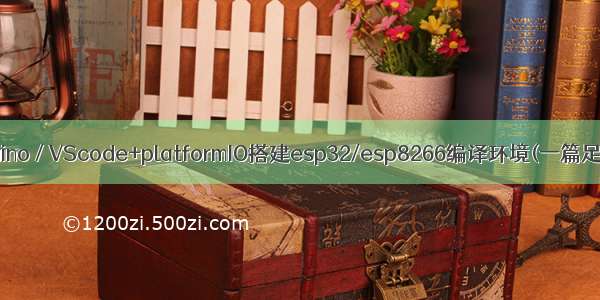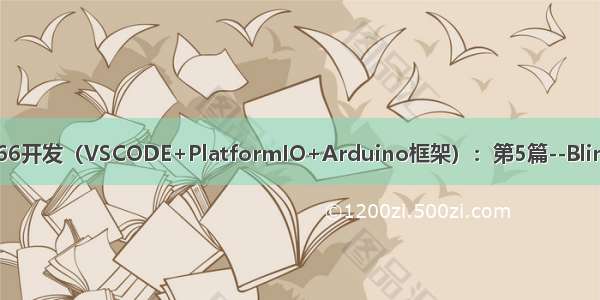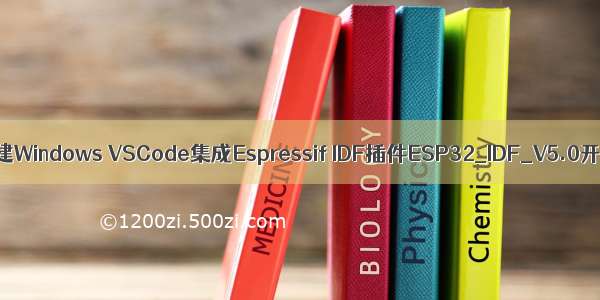
arduino/VScode+platformIO 搭建esp32/esp8266开发环境(一篇足矣)
前言:入门开源硬件开发,在搭建编译环境的时候碰了一脸灰,特意写下此博客,以供参考!结尾还有micropython+esp32/esp8266环境搭建的入口,千万不要错过哦~
文章目录
arduino/VScode+platformIO 搭建esp32/esp8266开发环境(一篇足矣)arduino esp32/esp8266环境下载软件安装软件软件设置扩展库示例编译与上传VScode+PlatformIO esp8266/esp32环境软件下载工程创建工程目录说明嵌入式开发的hello_world-点亮第一盏灯导入第三方库arduino esp32/esp8266环境
下载软件
arduino v1.8.15: 【官网入口】【 微云入口】
esp32/esp8266离线安装库: 【下载入口】 密码:666
esp32库文档: 【github入口】
esp8266库文档: 【github入口】
说明: arduino本身是不支持esp32/esp8266开发的, 需要额外安装库文件
安装软件
安装arduino打开arduino->文件->首选项,在附加开发版管理器网址输入框中,填入以下网址:esp32: /package_esp32_dev_index.json
esp8266: /package_esp8266com_index.json保存退出arduino,打开esp32/esp8266离线安装库文件,双击安装即可
说明: 软件安装基本都是傻瓜式安装,在这里不过多赘述
软件设置
esp8266开发版:
说明:在淘宝上买到的带下载功能的开发版, 选择这两种开发版即可
串口频率:115200
时钟频率:80MHZ(图是错的哈)
esp32开发版:
说明:在淘宝上买到的带下载功能的开发版, 选择DOIT ESP32 DEVKIT即可
串口频率:115200
时钟频率:80MHZ(图是错的哈)
扩展库
arduino社区有很多优秀的扩展库可供使用, 因此很多硬件的驱动库不需要直接写,直接下载使用即可
路径:项目->加载库->管理库
由于arduino服务器在外国,所以有时会出现加载失败原因,不要怀疑自己网络原因哈
示例
下载到的库一般都会有许多示例可供参考,这里以oled驱动库为例
路径:文件->示例->ESP8266 and ESP32 OLED driver-> SSD1306SimpleDemo
示例上一般都会有详细注释,可以很方便的入门使用
库文件保存路径:
C:\Users\{youname}\Documents\Arduino\libraries
编译与上传
一般都要先编译试错,然后再上传
注:上传有时会出现错误或卡顿现象,可以通过以下方式排错
在右下角检查接口是否正确连接
上传的时候按住板子上的FLASH(esp8266)或BOOT(esp32)键
检查程序是否出错
VScode+PlatformIO esp8266/esp32环境
说明:arduino好是好,就是编程的时候没有智能提示,对于我这种三板斧的人来说无疑是致命的。于是自然而然的就在网上找到了vscode+platformIO组合,vscode是微软优秀的开发者工具,而platformIO是优秀的嵌入式开发平台,支持arduino,stm32,esp序列,C51等单片机的编译和烧录,二者结合简直就是如虎添翼。
软件下载
vscode下载: 【官网入口】【蓝筹云入口】
PlatformIO官网文档: 【官网入口】
PlatformIO插件安装: 点击左侧栏的扩展 -> 搜索platformIO -> 安装第一个插件
由于是通过C/C++进行编译的,所以为避免出错,vscode最好先搭建好C/C++编译环境
安装如下插件:
C/C++
C/C++ Clang Command Adapter
C/C++ Snippets
C++ Intellisense
工程创建
插件安装好后会在左侧栏自动生成一个蜜蜂图标,点击进入平台主页(或选择点击左下角的小房子)
主页说明:
安装esp32/esp8266固件
创建hello_word工程点击
Platforms -> Embedded -> 输入框搜索espressif8266/espressif32 -> 选择对应的固件安装注:首次安装会很慢,快着几秒钟,慢着几个钟,耐心等待即可,第一次之后就会变快了,或者自行百度找办法
点击
home -> new project工程名:自行命名
板子类型:esp8266选择NodeMCU1.0(ESP-12E Modoule)/esp32选择DOIT ESP32 DEVKIT V1
框架:选择arduino即可
注:首次创建会非非非常的慢
工程目录说明
串口频率设置: monitor_speed = 115200(放在platformio.ini文件中即可)
嵌入式开发的hello_world-点亮第一盏灯
在./src/main.cpp中输入如下代码
#include <Arduino.h>void setup() {// put your setup code here, to run once:Serial.begin(115200); //初识化串口波特率pinMode(2, OUTPUT); //设置GOIP2引脚为输出模式digitalWrite(2, LOW); //设置GOIP2引脚为低电平}void loop() { // put your main code here, to run repeatedly:digitalWrite(2, HIGH); //设置GOIP2引脚为高电平Serial.println("LED: ON"); //串口台中输入delay(500); //延迟500msdigitalWrite(2, LOW); //设置GOIP2引脚为低电平Serial.println("LED: OFF");delay(500);}
注:源文件一般都含有setup和loop函数, setup函数用于初识化配置,像引脚的输入输出配置,外部中断等,loop函数就是一个循环体,是单片机持续执行的地方
先编译再上传(左下角)
编译通过
上传成功
控制台输出
编译通过但上传失败:
查看接口是否正确连接查看串口频率设置正确上传的时候按住BOOT/FLASH键
以上都不行可以尝试拔掉重连
2引脚连接的是板子上的led灯,实验现象就是LED一闪一闪亮晶晶
导入第三方库
同arduino,platformIO同样有许多第三方库文件,其路径
home->libraries->搜索框搜索
这里以ESP8266 and ESP32 OLED driver for SSD1306 displays库为例
注:用到oled显示屏 I2C版,可以去淘宝买一块,没有的话下面的内容可以不用看了
配置说明:一般来说导入工程的同时也会自行设置配置文件,但难免有出错或者自己想设置库文件版本的时候
第三方库的使用
选择库中的一个案例(路径:./.pio/libdeps/example/SSD1306SimpleDemo)
修改案例(讲解如下)
#include <Wire.h> // Only needed for Arduino 1.6.5 and earlier#include "SSD1306Wire.h" // legacy: #include "SSD1306.h"// Optionally include custom images#include "images.h" //图像十六进制头文件// 初识化显示屏:vcc->3.3V/5V GND-地 SDA:数据信号->D22 SCL: 时钟信号->D33 SSD1306Wire display(0x3c, 22, 23); // ADDRESS, SDA, SCL - SDA and SCL usually populate automatically based on your board's pins_arduino.h#define DEMO_DURATION 3000 //页面切换时间:3stypedef void (*Demo)(void); //定义页面列表int demoMode = 0; int counter = 1; //进度条计数void setup() {Serial.begin(115200); //串口波特率115200Serial.println();Serial.println();// Initialising the UI will init the display too.display.init(); //初识化oleddisplay.flipScreenVertically(); //作用,翻转屏幕display.setFont(ArialMT_Plain_10); //设置字体, 字体文件路径:./.pio/libdeps/src/OLEDisplayFonts.h}// 编写不同字体案例void drawFontFaceDemo() {//通过下面网站可创建一个自己喜欢的字体,复制到./.pio/libdeps/src/OLEDisplayFonts.h文件中//通过display.setFont()函数设置自己喜欢的字体// create more fonts at http://oleddisplay.squix.ch///display.setTextAlignment() 设置字体对齐方式display.setTextAlignment(TEXT_ALIGN_LEFT); display.setFont(ArialMT_Plain_10);display.drawString(0, 0, "Hello world");display.setFont(ArialMT_Plain_16);display.drawString(0, 10, "Hello world");display.setFont(ArialMT_Plain_24);display.drawString(0, 26, "Hello world");}// 编写自动换行案例void drawTextFlowDemo() {display.setFont(ArialMT_Plain_10);display.setTextAlignment(TEXT_ALIGN_LEFT);display.drawStringMaxWidth(0, 0, 128,"Lorem ipsum\n dolor sit amet, consetetur sadipscing elitr, sed diam nonumy eirmod tempor invidunt ut labore." );}// 编写字体不同对齐方式案例void drawTextAlignmentDemo() {// Text alignment demodisplay.setFont(ArialMT_Plain_10);// The coordinates define the left starting point of the textdisplay.setTextAlignment(TEXT_ALIGN_LEFT);display.drawString(0, 10, "Left aligned (0,10)");// The coordinates define the center of the textdisplay.setTextAlignment(TEXT_ALIGN_CENTER);display.drawString(64, 22, "Center aligned (64,22)");// The coordinates define the right end of the textdisplay.setTextAlignment(TEXT_ALIGN_RIGHT);display.drawString(128, 33, "Right aligned (128,33)");}// 编写填充,直线,斜线等图案案例void drawRectDemo() {// Draw a pixel at given positionfor (int i = 0; i < 10; i++) {display.setPixel(i, i);display.setPixel(10 - i, i);}display.drawRect(12, 12, 20, 20);// Fill the rectangledisplay.fillRect(14, 14, 17, 17);// Draw a line horizontallydisplay.drawHorizontalLine(0, 40, 20);// Draw a line horizontallydisplay.drawVerticalLine(40, 0, 20);}// 画圆案例void drawCircleDemo() {for (int i=1; i < 8; i++) {display.setColor(WHITE);display.drawCircle(32, 32, i*3);if (i % 2 == 0) {display.setColor(BLACK);}display.fillCircle(96, 32, 32 - i* 3);}}// 画进度条案例void drawProgressBarDemo() {int progress = (counter / 5) % 100;// draw the progress bardisplay.drawProgressBar(0, 32, 120, 10, progress);// draw the percentage as Stringdisplay.setTextAlignment(TEXT_ALIGN_CENTER);display.drawString(64, 15, String(progress) + "%");}// 画xbm图片案例void drawImageDemo() {// see //05/esp8266-nodemcu-how-to-create-xbm.html// on how to create xbm filesdisplay.drawXbm(34, 14, WiFi_Logo_width, WiFi_Logo_height, WiFi_Logo_bits);}Demo demos[] = {drawFontFaceDemo, drawTextFlowDemo, drawTextAlignmentDemo, drawRectDemo, drawCircleDemo, drawProgressBarDemo, drawImageDemo};int demoLength = (sizeof(demos) / sizeof(Demo));long timeSinceLastModeSwitch = 0;void loop() {// 清屏display.clear();// 调用案例函数demos[demoMode]();display.setTextAlignment(TEXT_ALIGN_RIGHT);display.drawString(10, 128, String(millis()));// 将缓冲区写入显示display.display();// 用于计时,切换页面if (millis() - timeSinceLastModeSwitch > DEMO_DURATION) {demoMode = (demoMode + 1) % demoLength;timeSinceLastModeSwitch = millis();}counter++;delay(10);}
编译上传(这里不再演示)
接线说明(这里以esp32为例,esp8266的没有22,23引脚,需要自行更改)
效果展示
当然嵌入式开发不止可以用C/C++,还能用python进行程序编写,这就需要用到Micropython。
下一篇博客《Micropython+esp32/esp8266开发环境》【传送门】














